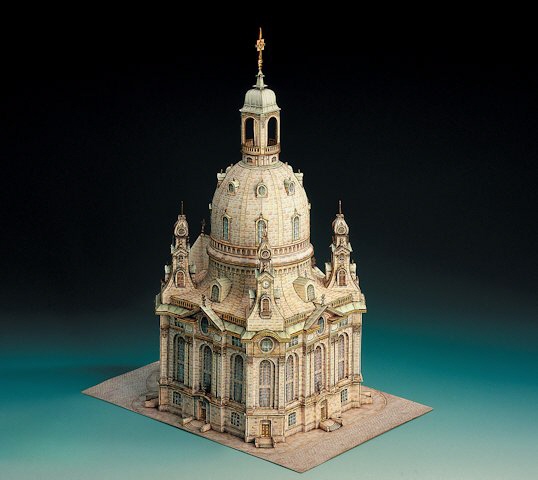Dresden Frauenkirche

Scale: 1:300
Length: 27 cm
Width: 19 cm
Height: 34 cm
Degree of difficulty: 3 (difficult)
Number of sheets: 7.5
The Church of Our Blessed Lady (Frauenkirche) in Dresden
When the Church of Our Blessed Lady in Dresden fell prey to bomb attacks in February 1945, the precious ceiling paintings as well as the Silbermann pipe organ were lost for ever. Protectors of historical monuments were at least able to achieve the preservation of the ruins to serve as a memorial for future generations.
The construction of the Protestant Church of Our Blessed Lady was ordered in 1722 following the example of numerous Italian churches. The cupola was built of solid rock - a bold construction for the current time. The construction was completed in 1743. The walls of the church were so solid, that the Prussian cannon balls fired at them during the Seven Years’ War simply bounced off. It is said, that Frederick the Great made the following comment upon being faced with the non-budging obstacle: “So let the stubborn bugger be.”
Approximately € 130 million are needed for a reconstruction of the building, the main source being donations. This sum would be sufficient, to employ about 50 to 60 stone movers and masons required to restore the building from the remaining stones existing as good as possible. In this context the value of detailed drawings and plans made due to various refurbishments shortly before the destruction is immeasurable. About a third of the building can be restored from original materials. For the rest, stone from the sandstone quarries of the Elbe river in Saxon Switzerland is used - just as for the original in the 18th century.
Donations for the Church of Our Blessed Lady are raised not only in Germany - for example, the tower cross was funded with approximately € 450 000 coming from England. The cross was crafted in London as well by Alan Smith, who manufactured the work of art with a height of 7.60 meters using gold. Smith is the son of a pilot who participated in the bombings of Dresden during the Second World War. During the ceremony at which the cross was handed over, the head-of the Protestant Church of Saxony, Volker Kreli, stated, that by this act the dream of reconciliation and friendship finally came true 55 years after the attacks.
